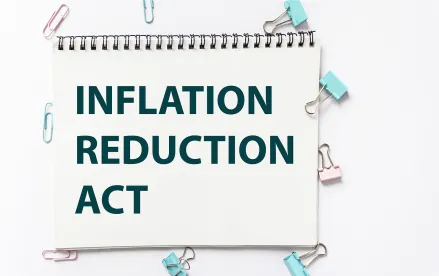On February 13, 2023, the Internal Revenue Service (“IRS”) issued its “initial guidance”[1] regarding the Low-Income Communities Bonus Credit Program (the “Program”) established by the Inflation Reduction Act of 2022 (the “IRA”)[2] and codified under new Section 48(e) of the Internal Revenue Code (“IRC”) concerning “special rules for certain solar and wind facilities placed in service in connection with low-income communities.” The guidance makes strides to implement the Program required by the IRA, but it also leaves some gaps to be addressed in more guidance to come.
The Low-Income Communities Bonus Credit Program created by IRC Section 48(e) will be short-lived and covers only 2023 and 2024.[3] The Program will allocate potential bonus credits among projects totaling up to 1.8 gigawatts (“GW”) each year in 2023 and 2024, and allows a 10% or 20% tax credit bonus (commonly called “adders”) on top of the energy investment tax credits that may otherwise be available under IRC Section 48[4] for solar and wind facilities with a net output of less than 5 megawatts (“MW”) as measured in alternating current.[5] Such facilities may include an energy storage component, which will be added to “eligible property” for purposes of calculating the value of the adder.[6] The annual 1.8 GW available for allocation is referred to in IRC Section 48(e)(1) as the “environmental justice solar and wind capacity limitation,” furthering the goal of increasing “access to renewable energy facilities in low-income and other communities with environmental justice concerns.”[7]
The allocation of an amount of capacity limitation should not be considered a determination that the facility will qualify for the tax credit or the bonus credit since other steps are necessary (e.g., the completion of construction) before any credit may be claimed and continued compliance with the terms of an award of capacity limitation is required to avoid recapture.[8] The initial guidance does not address recapture triggers or the ability to remedy noncompliance to avoid recapture.
Project Categories
Project eligibility is based on certain criteria outlined by the IRS in the four categories discussed below. Pursuant to IRC Section 48(e)(2)(A)(iii), eligibility under Categories 1 and 2 may garner a 10% adder whereas eligibility established under Categories 3 and 4 may result in a 20% adder.
Category 1. The facility is located in a “low-income community” as defined by Section 45D(e) for the New Markets Tax Credit Program,[9] including:
(i) a census tract with a poverty rate of at least 20%;
(ii) a census tract not located in a metropolitan area with a median family income of not more than 80%[10] of the statewide median family income;
(iii) a census tract located in a metropolitan area with a median family income of not more than 80%[11] of the statewide median family income or the metropolitan area median family income;
(iv) an area not tracked for population, an equivalent county division as defined by the Bureau of Census as a poverty area; or
(v) a census tract with low population (less than 2,000 people) if in an empowerment zone or contiguous to a low-income community determined by (i) through (iv) above.
The IRS has allocated 700 MW for Category 1 projects in 2023.
Category 2. The facility is located on “Indian land” as defined by Section 2601(2) of the Energy Policy Act of 1992.
The IRS has allocated 200 MW for Category 2 projects in 2023.
Category 3. The facility is installed/constructed at a residential rental building that is part of an “affordable housing program” and the financial benefits of the electricity produced by the facility are allocated equitably among the residents of the building. An “affordable housing project” is broadly defined under 34 U.S.C. §12491(a)(3) (“covered housing program”) as virtually “all Federal housing programs providing affordable housing to low- and moderate-income persons by means of restricted rents or rental assistance, or more generally providing affordable housing opportunities….”[12]
The IRS has allocated 200 MW for Category 3 projects in 2023.[13]
Category 4. The facility is qualified as a “low-income economic benefit project,” by providing at least 50% of the financial benefits of the electricity produced by the facility to households with income of less than (i) 200% of the “poverty line” determined annually by the Office of Management and Budget using census data and based on size of household,[14] or (ii) 80% of the “area median gross income” as determined by the U. S. Department of Housing and Human Development.[15]
The IRS has allocated 700 MW for Category 4 projects in 2023.[16]
It may be challenging to demonstrate eligibility under Categories 3 and 4 of the Low-Income Communities Bonus Credit Program in order to take advantage of the 20% adder. Eligibility must be carefully evaluated on a project-by-project basis. For both of these categories, under IRC Section 48(e)(2)(d), providing electricity to low-income households at below market rate will be considered a financial benefit. However, the IRS also indicated that further guidance is required to “clarify the parameters of financial benefit.”[17]
Applications
Although the IRS has left open many of the details of the application process for later guidance, it has established significant program elements in this initial guidance. For example, a facility seeking credits for 2023 may only apply for an allocation in one category. Applicants who do not receive an allocation in 2023 may apply for 2024. Applications will be accepted on a staggered basis by the IRS during 60-day application windows and those within Categories 3 and 4 will be considered first, likely in the third quarter of 2023. To assist the IRS, the U.S. Department of Energy (“DOE”) will review the applications for statutory eligibility and other criteria, which may include whether a facility is commercially ready for development, will be owned or developed by a community-based organization, or provide other substantial benefits to the community.[18] Additional criteria will be addressed in the future guidance.
Notably, although the statute under IRC Section 48(e)(4)(A) provides that the IRS will provide procedures to allow for an efficient allocation process, including the consideration of multiple projects in a single application if such projects will be placed in service by a single taxpayer, the initial guidance does not address this standard. The 5 MW maximum threshold applies to “facility” capacity and each wind turbine or block of a solar project may be a facility capable of operating independently. It is left to future guidance to determine whether a qualified facility that must meet the 5 MW standard may consist of a single wind turbine considered together with other wind turbines or a block of a solar considered with other blocks of solar that are part of the same project. Allowing the 5 MW standard to be satisfied on a per qualified facility basis (rather than as a limitation on the capacity of the entire project) would expand the number of projects eligible to participate and increase the likelihood that the annual capacity limitation will be fully allocated.
The amount of the capacity limitation allocated to a facility may not exceed the facility’s nameplate capacity. In the event the IRS allocates a capacity limitation that is less than the full nameplate capacity, under IRC Section 48(e)(1)(B), the adder will be proportionate to the ratio of the allocated capacity to the total nameplate capacity of the facility, as measured in direct current. Under IRC Section 48(e)(4)(E), applicants have four years from the date of allocation to place the facility in service.
Oversubscription/Underutilization
Per the guidance, if the program is oversubscribed by applications, a lottery may be considered. Excess capacity in one category may be reallocated to another category to maximize the 2023 allocation. Any unallocated MW capacity from 2023 will be rolled over and added to the 1.8 GW allocation for 2024.[19] After 2024, a program similar to the Low-Income Communities Bonus Credit Program will be continued under new IRC Section 48E(h) with IRS guidance due for that program by January 1, 2025.[20]
FOOTNOTES
[1] IRS Notice 2023-17, Initial Guidance Establishing Program to Allocate Environmental Justice Solar and Wind Capacity Limitation Under Section 48(e) (irs.gov) (the “Notice”).
[2] See Section 13103 of Public Law 117-169, 136 Stat. 1818 (August 16, 2022). The IRS was required to set up the Low-Income Communities Bonus Credit Program within 180 days of enactment of the IRA.
[3] New IRC Section 48E(h), 26 U.S.C. §48E(h), requires the establishment of a similar low-income tax credit bonus program by January 1, 2025.
[4] See, generally, 26 U.S.C. §48 (Energy Credit).
[5] See 26 U.S.C. §§48(e)(1)(A), 48(e)(2)(A)(ii) and 48(e)(4)(C).
[6] See 26 U.S.C. §§48(e)(1)(A) and 48(e)(3).
[7] Notice at 7.
[8] Notice at 10.
[9] See, generally, 26 U.S.C. §45D.
[10] Per IRC, Section 45D(e)(5), The 80% is changed to 85% for a census tract in a “high migration rural county,” defined as a county in which, during the 20-year period ending with the year of the most recent census (i.e., 2000-2020), the population has decreased by at least 10%.
[11] Id.
[12] 34 U.S.C. §12491(a)(3)(P). “Covered housing” in 42 U.S.C. §12491(a)(3) includes supportive housing for homeless persons, the elderly, persons with disabilities, low-income veterans, and victims of domestic, as well as housing constructed under the low-income tax credit program and other federally funded housing programs. Each building to be proposed as included in Category 3 of the Low-Income Communities Bonus Credit Program should be evaluated for eligibility.
[13] If a project that falls under Category 3 is also eligible under Categories 1 or 2, the category considered for purposes of allocation will be Category 3.
[14] IRC §48(e)(2)(C) refers to “poverty line” as defined in IRC §36B(d)(3)(A), which refers to 42 U.S.C. 1397jj(c)(5) (the Social Security Act), which in turn refers to the definition of “poverty line” in 42 U.S.C. §9902(2) (U.S. Department of Health and Human Services Community Block Grant Program).
[15] IRC §48(e)(2)(C) refers to the “area median gross income” as determined by IRC §142(d)(2)(B), which refers to the definition in 42 U.S.C.1437(b)(2)(A) for Section 8 housing.
[16] If a project that falls under Category 4 is also eligible under Categories 1 or 2, the category considered for purposes of allocation will be Category 4.
[17] Notice at 7.
[18] DOE will make recommendations to the IRS whether or not to grant the facility’s requested allocation, and the IRS will wholly accept or reject DOE’s recommendation. Notice at 10.
[19] Notice at 5, 8-9.
[20] See fn. 3.





 />i
/>i
